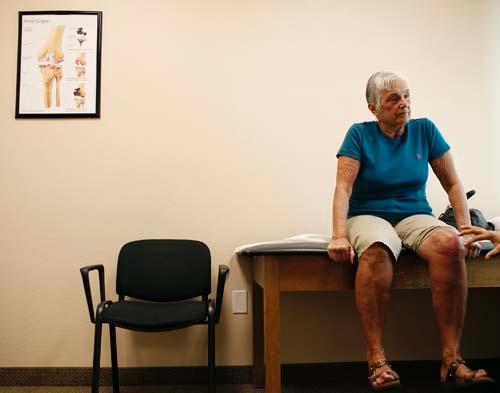Knee replacements can bring relief at last

At the age of 52, Rudy Strukoff feels like an old man.
He’s a musician who can’t book guitar gigs anymore for fear of falling onstage. Regular activities – walking down the stairs or stepping up on a sidewalk, for instance – have become fraught with danger. In fact, he fell a few weeks ago.
He can’t ride his bike anymore or even walk on a treadmill because it makes his knee hurt. Actually, that’s not true because his knee never stops hurting. Activity just makes it worse.
And now, he’s become a cliche, constantly complaining about the pain. But Strukoff, who owns the downtown LaChica Art and Music gallery, can’t help it. The pain has become unbearable. And nothing eases it.
So, on Nov. 27, Strukoff will have his left knee replaced.
Nationally, the number of total knee replacements, a procedure in which an orthopedic surgeon removes a patient’s natural knee and replaces it with a prosthesis, has nearly doubled in recent years. The surgery requires the removal of part of the femur, tibia and patella.
In 2002, about 350,000 knee replacements were done in this country. In Nevada, 1,800 procedures were done that same year. In 2010, there were 658,000 total knee replacements done in America, with 3,800 of them performed in Nevada, statistics from the American Academy of Orthopedic Surgeons show.
By 2030, the number of total knee replacements in this country is expected to grow by 600 percent, says academy spokesman Dr. Danton Dungy.
A total knee replacement has always been a last resort, done only when a patient’s life is negatively affected by severe pain from conditions such as arthritis. But it’s easier than ever to replace a knee and the outcome for the procedure is better than ever, Dungy says.
That, combined with other factors, including an aging boomer population, illustrate why total knee replacements have been increasing.
Osteoarthritis, which comes with age and wear and tear of the joint, is the No. 1 cause of knee pain that leads to a total knee replacement, Dungy says. Every day for the next 18 years, 10,000 people will turn 65.
More Americans are obese, which puts stress on knee joints and exacerbates arthritis. People are also more athletic and suffer trauma that causes arthritis. That’s what happened to Strukoff; he played football in high school and had to quit after a doctor told him he could ruin his knees.
The procedure is covered by most insurance companies, although the individual cost varies, Dungy says. It is usually treated as any other surgical procedure, with the patient paying what his or her insurance dictates for surgeries. Strukoff estimates he will spend a few thousand dollars for his knee replacement.
In the past, doctors encouraged knee replacement candidates to put the surgery off for as long as possible, because the implants were said to have a life span of 15 to 20 years, notes Dr. Scott Martin, a Las Vegas orthopedic surgeon. Now, the materials are lasting longer and doctors are operating on younger patients.
Martin uses a knee implant that is supposed to last for 30 years. About 40 percent of his patients are joint replacement candidates. He performs between 200 and 250 total knee replacements a year, he says.
Although a knee replacement is never as good as your own knee, it can significantly improve the quality of life for someone whose life has been negatively affected by knee pain, Martin says.
“It changes your life so dramatically,” says Sylvia Schwartz, 71.
She had her left knee replaced in September and returned to her office job five weeks later.
The recovery time for the procedure varies, doctors say. Patients who have desk jobs can often return to work in a few weeks. Others, such as the hospitality workers that Martin often sees, can take as long as 12 weeks before they can return to their jobs.
But most patients, no matter their circumstances, are usually up and walking only hours after the surgery. The recovery requires patients to be more involved than in other procedures, Dungy says. Those who are dedicated to their physical therapy regimens often have better outcomes.
Contact reporter Sonya Padgett at
spadgett@reviewjournal.com or 702-380-4564.
Follow @StripSonya on Twitter.